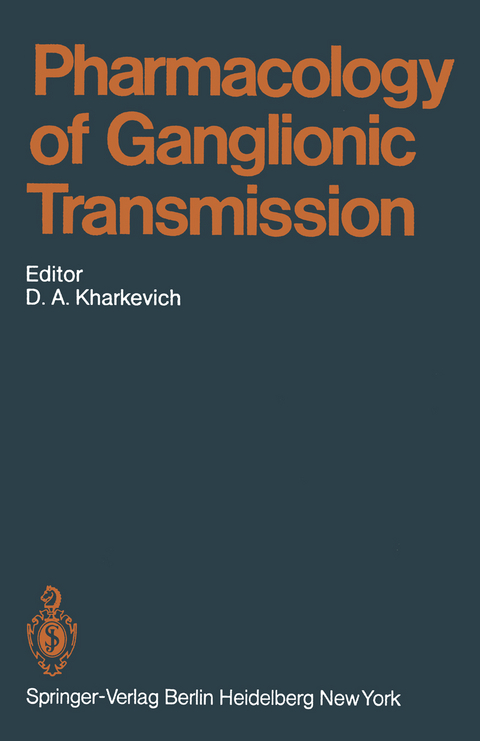
Pharmacology of Ganglionic Transmission
Springer Berlin (Verlag)
978-3-642-67399-3 (ISBN)
D.A. KHARKEVICH The history of the study of ganglionic substances begins with the paper of LANGLEY and DICKINSON (1889), who established the ability of nicotine to block the neurones in the superior cervical ganglion. This was a considerable discovery as the authors ascertained that impulses were transmitted from pre- to postganglionic neurones in the autonomic ganglia. Simultaneously they indicated the possibility of pharmaco logical influence upon interneuronal transmission in autonomic ganglia. The idea of ganglionic receptors specifically sensitive to nicotine followed logically. Later, LANGLEY (1905, 1906) considered the problem of receptors with respect to neuro-effector synapses. It is remarkable that he was one of the first to put forward the theory of chemical mediation of excitation (" ... the nervous impulse should not pass from nerve to muscle by an electric discharge, but by the secretion of a special substance at the end of the nerve": LANGLEY, 1906, p. 183). In addition, LANGLEY JOHN N. LANGLEY (1852-1926) D.A. KHARKEVICH 2 and his collaborators managed to define the topography of autonomic ganglia more precisely by means of nicotine. It should be mentioned that it was he who introduced the terms "autonomic nervous system" and "parasympathetic nervous system".
1 Ganglionic Transmission: Morphology and Physiology.- A. Pathways in the Autonomic Ganglia.- B. Synaptic Transmission in Autonomic Ganglia.- C. Summary.- References.- 2 Ganglionic Metabolism.- A. Carbohydrate Metabolism.- B. Stimulation.- C. Nonglucose Metabolites Substrates.- D. Lipids.- E. Amino Acids.- F. Uptake and Efflux of Amino Acids.- G. RNA Protein.- H. Protein.- References.- 3 Methods for the Examination of Ganglion-Blocking Activity.- A. Introduction.- B. General Physiological and Pharmacological Aspects of the Evaluation of Ganglion-Blocking Agents.- C. Pharmacological Methods.- D. Preparations Other Than Autonomic Ganglia Used for Evaluation of Ganglion-Blocking Agents.- E. Screening for Ganglion-Blocking Activity.- F. Evaluation of Non-Nicotinic Ganglion-Blocking Agents.- G. Methods for the Determination of Absorption, Distribution, and Excretion of Ganglion-Blocking Agents.- H. Clinical Testing of Ganglion-Blocking Agents.- J. Critical Appraisal of the Experimental Methods Used in the Evaluation of Ganglion-Blocking Agents.- K. Conclusions.- References.- 4a Relationship Between Chemical Structure and Ganglion-Blocking Activity. a) Quaternary Ammonium Compounds.- A. Introduction.- B. Structure-Activity Relationships in Different Structural Types of Quaternary Ganglion-Blocking Agents.- C. Conclusions.- References.- 4b Relationship Between Chemical Structure and Ganglion-Blocking Activity. b) Tertiary and Secondary Amines.- A. Introduction.- B. Structure-Activity Relationships in Different Structural Types of Non-Quaternary Ganglion-Blocking Agents.- C. Conclusions.- References.- 5 Locus and Mechanism of Action of Ganglion-Blocking Agents.- A. Introduction.- B. Competitive Blocking Agents.- C. Depolarising Agents.- D. Intraganglionic Distribution of Ganglion-Blocking Drugs.- Addendum.- References.- 6 Action of Ganglion-Blocking Agents on the Cardiovascular System.- A. Introduction.- B. Hypotensive Action.- C. Cardiac Function.- D. Systemic Vascular Beds.- I. Cerebral Circulation.- II. Renal Circulation.- III. Pulmonary Circulation.- IV. Splanchnic Circulation.- V. Limb Circulation.- E. Conclusions.- References.- 7 Action of Ganglion-Blocking Agents on the Gastrointestinal Tract..- A. Introduction.- B. Salivary Secretion.- C. Oesophagus and Cardiac Sphincter.- D. Gastric Motility.- E. Gastric Secretion.- F. Pancreatic Secretion.- G. Small Intestine.- H. Colon.- References.- 8 Absorption, Distribution, Fate, and Excretion of Ganglion-Blocking Compounds..- A. Introduction.- B. Onium Compounds.- C. Secondary and Tertiary Amines.- References.- 9 Nicotinic Ganglion-Stimulating Agents.- A. Introduction.- B. Pharmacological Ambiguities of Ganglionic Receptors.- C. Postjunctional Responses to Acetylcholine and Nicotinic Agents.- D. Blockade of Transmission by Nicotinic Drugs.- E. Denervated Ganglia.- F. Conclusions.- References.- 10 Non-Nicotinic Chemical Stimulation of Autonomic Ganglia.- A. Introduction.- B. Muscarinic Ganglion Stimulants.- C. 5-Hydroxytryptamine (5-HT) and Related Indolealkylamines.- D. Histamine.- E. Polypeptides.- F. Cardiac Glycosides.- G. Veratrum Alkaloids.- H. Batrachotoxin.- J. Inorganic Cations.- K. Conclusions.- References.- 11 Ganglion Activity of Centrally Acting Neurotropic Agents..- A. Introduction.- B. Methods.- C. Volatile Anaesthetics.- D. Central Nervous System Depressants.- E. Neuroleptics.- F. Antidepressants.- G. Anti-Manic Drugs.- H. Narcotic Analgesics.- J. Central Nervous System-Stimulant Drugs.- K. Tranquillisers.- L. Anticonvulsant Drugs.- References.- Note Added in Proof.- 12 Ganglionic Actions of Anticholinesterase Agents, Catecholamines, Neuro-Muscular Blocking Agents, and Local Anaesthetics.- A. Anticholinesterase Agents.- B. Catecholamines.- C. Neuromuscular Blocking Agents.- D. Local Anaesthetics.- E. Conclusions.- References.- 13 Ganglionic Activity of Cardiovascular Drugs..- A. Introduction.- B. Antihypertensive Drugs.- C. Vasoconstrictors.- D. Cardiotropic Drugs.- References.- 14 Ganglion-Blocking Agents in Internal Medicine..- A. Introduction.- B. Ganglion-Blocking Agents in the Treatment of Hypertension.- C. Ganglion-Blocking Agents in the Treatment of Peptic Ulcer.- References.- 15 Ganglion-Blocking Agents in Anaesthesiology..- A. Introduction.- B. General Characteristics of the Use of Ganglion-Blocking Agents for Artificial Hypotension.- C. Use of Artificial Vasodilatation for Various Surgical Interventions and Pulmonary Oedema.- References.- Author Index. V.V. Maisky.- Subject Index. V. V. Maisky.
| Erscheint lt. Verlag | 15.11.2011 |
|---|---|
| Reihe/Serie | Handbook of Experimental Pharmacology |
| Co-Autor | D.M. Aviado |
| Zusatzinfo | XVI, 534 p. |
| Verlagsort | Berlin |
| Sprache | englisch |
| Maße | 170 x 244 mm |
| Gewicht | 946 g |
| Themenwelt | Medizin / Pharmazie ► Medizinische Fachgebiete ► Pharmakologie / Pharmakotherapie |
| Medizin / Pharmazie ► Pharmazie ► PTA / PKA | |
| Schlagworte | Acetylcholin • Alkaloids • Analgesics • Butyrophenone • CNS • Ganglion • Histamin • Hormone • Metabolism • Nicotin • pharmacology • Phenothiazine • Physiology • Rauwolfia • Thioxanthene • Toxicity |
| ISBN-10 | 3-642-67399-6 / 3642673996 |
| ISBN-13 | 978-3-642-67399-3 / 9783642673993 |
| Zustand | Neuware |
| Haben Sie eine Frage zum Produkt? |
aus dem Bereich


